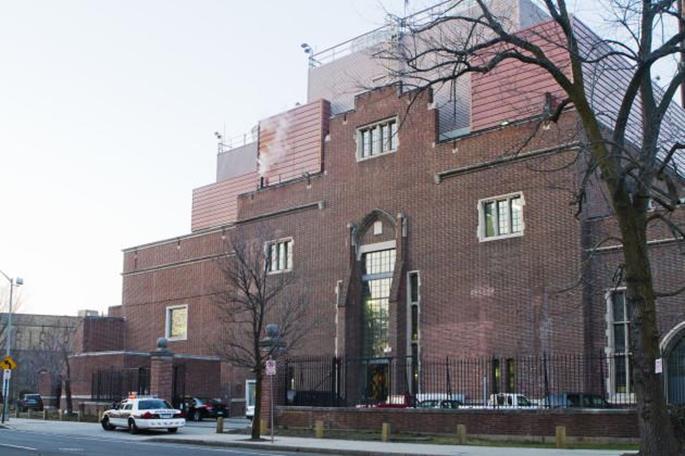Sylvia McNamara, Julian Sagastume, Ronald Taitz
Introduction
Two broad trends characterize New Haven’s energy infrastructure: regional interconnectedness and internal bifurcation. As a major port and transport hub of the south central Connecticut region, the city connects regional, local, and global energy networks. New Haven generates and aggregates regional electricity and acts as a major hub for petroleum products. In this regard, the lines between city and region are somewhat blurred: New Haven depends on surrounding towns for energy generation and visa versa. Within the city, energy infrastructure is less interwoven: significant bifurcation exists between the city’s energy grid and that of its largest property owner—Yale University. Yale maintains separate electricity and heat generation and distribution networks. These are frequently more efficient and technologically advanced than the corresponding public networks, which have a legacy of lagging behind on necessary improvements. Yale’s separate network indicates its broader desire to insulate itself from the vicissitudes of the city that surrounds it. Energy infrastructure in New Haven demonstrates interesting contrasts: as a regional hub, New Haven’s energy infrastructure binds together the South Central Connecticut region but the tremendous diversity of networks and divisions within the city also lead to patterns of division and decentralization.

Yale Central Power Station
Electricity
The United Illuminating Company is the regional electric company for southwestern Connecticut and it serves the cities of New Haven and Bridgeport. The enterprise began in 1881 as the New Haven Electric Lighting Co., which operated under a charter granted by the Connecticut General Assembly to supply electric lighting to public buildings and streetlights in New Haven. The company, which used the Weston system of arc lighting, quickly failed due to its inability to produce satisfactory lighting. In 1883, the company reorganized as the New Haven Electric Co., headquartered at 844 Chapel Street. The company, using the Thompson-Houston improvements to the arc lamp, first sold contracts for individual electric lights to private residences and businesses, and then moved on to service larger businesses and institutions like Yale.

Generation equipment at the headquarters of the New Haven Electric Co., a local utility that regionalized and became United Illuminating in 1899. The company at the time of this photograph served private residences, small businesses, and several large institutions, including Yale. This building was located at 844 Chapel St. in New Haven.
Source: http://images.library.yale.edu/nhsize3/YVRC/D9990/258054.jpg
A Regional Organization
At first, the reorganized company’s charter was granted to provide electric lighting exclusively in New Haven. The New Haven Electric Co., however, aspired to become a regional utility, and was allowed by the State of Connecticut to reorganize its charter in 1899. The company renamed itself United Illuminating and swiftly purchased the Bridgeport Electric Light Company. United Illuminating expanded steadily throughout the early twentieth century, adding significant generation and distribution capacity in the 1920s with investments in distribution lines and the construction of the English Station plant on the Mill River in New Haven.
In the 1950s and 1960s, booming postwar demand for power forced United Illuminating to begin pooling energy production and distribution capabilities with other utilities in the region. This practice allowed the different utilities to manage power loads throughout the day. In 1975, UI added another generating station in New Haven, the New Haven Harbor Station, which burned coal, residual oil, and natural gas. The company simultaneously added several generation facilities in Bridgeport.
The Advent of Nuclear Power
In addition to adding these fossil fuel plants, United Illuminating anticipated rising electric demand by investing in nuclear power. In 1962, UI bought shares in the Connecticut Yankee Atomic Power Company to build a nuclear plant in Middlesex County, Connecticut. Despite UI’s significant investment in nuclear, UI’s overall fuel mix still relied heavily on foreign oil—about ninety percent. That changed with the OPEC embargo of the mid-1970s. UI’s electricity rates spiked, creating widespread anger among its customers. This event hastened UI’s expansion of its nuclear capacity in the late 1970s and 80s. Today, UI’s fuel mix is nearly 30% nuclear power, well above the national average (Fig 2).
Tree-Trimming Controversy
After a spate of severe storms from 2011-2013 that left many in the region without power, United Illuminating has unveiled a sweeping and controversial new plan for tree removal around power lines in order to protect power lines from falling branches. The plan calls for a pruning corridor in which branches and trees within eight feet on either side of a power line would be removed. According to the Garden Club of New Haven, this could result in the loss of up to half of New Haven’s trees. Many New Haveners have called for United Illuminating to bury lines underground instead of eliminating trees whose presence bolsters the streetscape and provides many environmental benefits. UI counters that burying lines is prohibitively expensive; it is estimated to cost one million dollars per mile and New Haven has about 750 miles of lines. The controversy over tree trimming is so heated that the issue has come before Connecticut’s Public Utilities Regulatory Authority (PURA). The debate may hinge on regulators’ opinions on climate change. Though New Haven has not been historically prone to severe storms, if the storms of the past three years are seen to indicate a future trend, then burying wires might make long-term financial sense. However, if regulators consider those storms to be anomalies, the tree-trimming may very well move forward.
The Question of English Station
The English Station Plant is a defunct power plant located on Ball Island in the Mill River neighborhood of New Haven. Built between 1924 and 1926, the plant is architecturally significant for its resemblance to a church–a cathedral to electricity. The plan was a major source of electricity until 1974 when UI built Harbor Station in East Shore. Since UI preferred to use the more efficient, modern Harbor Station, English Station became a “peaking unit,” activated only when other plants could not provide for the city’s electrical demands. As capacity in other regional plants grew, English Station was activated less and less frequently until the coal-fired plant was finally put into “deactivated reserve in 1992. In 2000, UI transferred ownership of the plant to an unaffiliated company, Quinnipiac Energy, paying the company $4.25 million to take over UI’s liability. English Station has passed from owner to owner since, and was slated for demolition in 2011. However, in 2011, just before the commencement of preliminary demolition, high levels of PCBs, a highly toxic cooling fluid, was found in 4,300 gallons of oil the plant’s owner, Asnat Realty, LLC, had attempted to sell. Connecticut’s Department of Energy & Environmental Protection (DEEP) quickly halted demolition , since demolishing the plant would leave the Mill River vulnerable to severe PCB contamination.
Since the halted demolition, community groups, regulators from federal and state agencies, and businesses with a stake in the site have fought over its future. For instance, some residents of the Fair Haven neighborhood find the plant to be an eyesore and advocate its removal, while groups like the New Haven Urban Design League wish to preserve the plant for its historical and architectural significance. Regulators, seeking a safe and speedy cleanup of the toxic contaminants at the site, have engaged in contentious negotiations with the several businesses named as liable for the site; the plant has changed ownership several times, and it is not clear where the financial burden of cleanup falls. As of the State’s most recent ruling, all of the plant’s current and former owners must submit and execute a plan to clean up the site before demolition can be considered. Liable companies are currently engaged in studying the contaminants at the site; the extent of pollution, nature of the cleanup, and future of the site remain unknown.
The New Haven Harbor Generating Station, located at 1 Waterfront Street in New Haven, is owned by New Jersey-based energy company Public Service Electricty and Gas Company (PSEG), and is a major energy supplier for United Illuminating. United Illuminating constructed the New Haven Harbor Generating Station as an oil-fired plant in 1975, and upgraded it to include natural gas burning capabilities in the 1980s. In the late 1990s through the early 2000s, the plant’s emissions were the subject of controversy when it became known that it had been contaminating New Haven’s air and water for decades. The plant had been constructed two years before Congress amended the Clean Air Act in 1977 and it was grandfathered from the new toxic emissions standards set for power plants. Environmental groups in the 1990s dubbed the plant a member of Connecticut’s “sooty six” toxic power plants and campaigned vigorously across the state to reduce its emissions. These efforts were rewarded in 2002 when statewide power plant modernization legislation was put in place. In 2003, UI sold the plant to PSEG, which worked with environmental groups to make the New Haven Harbor Generating Station one of the most efficient in the New England Power Pool.
In 2012, PSEG built an electric generating peaking facility at the New Haven Harbor Generating Station. Peaking facilities, which are typically added to base power plants, operate only during periods of peak energy demand (typically hot afternoons) in order to guarantee sufficient energy capacity without requiring a brand new generating facility. The New Haven peaking facility uses natural gas and ultra-low sulfur fuel oil, both of which are relatively clean burning.

Image: Saturation in Southern Connecticut Gas (SCG) and Connecticut Natural Gas (CNG) markets.
Source: Connecticut Department of Economic and Community Development.
Yale Power Plants
The Yale Central Power Plant, 120 Tower Parkway, New Haven, Connecticut. The natural gas fired power plant currently provides up to 50 percent of Yale’s campus with electricity, steam heat, and chilled water. The plant uses a process called cogeneration that captures energy emitted during electricity generation that would ordinarily be lost as heat and uses it to power steam generators, dramatically increasing the efficiency of the plant.
In April 2013, Yale administrators reported a plan to invest roughly $50 million to replace the three gas turbines at the Yale Central Power Plant. The current turbines, installed in 1997, have shown diminished efficiency and have required more expensive maintenance with age. The new turbines will have more modern energy-efficient technology and will spare Yale long-term maintenance costs.
The Sterling Power Plant, located at 309 Congress Avenue, provides electricity, steam, and chilled water to Yale’s medical campus and the Yale New Haven Hospital. In 2012, Yale renovated the plant to add cogeneration capabilities. In cogeneration, power plants not only generate electricity from turbines that consume fuel, but also uses the exhaust from these turbines to create steam and chilled water (from evaporation) for the heating and cooling of buildings. Design components implemented in the renovation included delivery logistics improvements around the site, measures to address air and water quality, the incorporation of an existing structure to reduce material consumption, and a green roof. The redesign dramatically increased efficiency and earned the facility the American Institute of Architects’ Connecticut Honor Award.
Alternative Energy
Yale University has made a conscious effort to diversify its energy portfolio with a combination of more environmentally friendly alternative and renewable energy sources. As of 2006, Yale has started running its shuttle buses on a B20 biodiesel and Ultra Low Sulfur Diesel blend, which although is a cleaner alternative to conventional diesel or unleaded gasoline fuel, it isn’t renewable. Yale has focused its renewable efforts on solar and wind energy technologies. A 100 kilowatt photovoltaic solar system is installed on Kroon Hall in the School of Forestry & Environmental Studies. Kroon Hall also boasts evacuated solar hot water tubes, which circulate water on the building’s roof which absorbs heat from the sun and provide the entire building with hot water. Yale’s Fisher Hall at the Divinity school utilizes a 40 kilowatt solar system, and a 24.5-kilowatt thin-film solar system is also utilized on the Yale College Swing dorm. On a much smaller scale, Yale also utilizes wind power with its micro wind turbines installed above the Becton Engineering and Applied Sciences Center in March of 2009. These 10 one kilowatt turbines are sensitive enough to pick up a 7 mile-per-hour breeze and can produce roughly 25 megawatt hours of energy per year: enough energy to power two average Connecticut homes.
According to United Illuminating’s 2010 sustainability report, one of the primary ways that UI is getting cleaner burning energy to its customers is through the New England East West Solutions projects, a group of related transmission projects developed by system planners from ISO-New England, Northeast Utilities, and National Grid (the utility serving eastern Massachusetts and Rhode Island). These projects improve the ability of the energy grid infrastructure to transmit energy by increasing the capacity of power lines at system “bottlenecks,” junctures which cannot handle excessive energy demand. This means that cleaner energy from across the region can reach customers more efficiently. Another measure that UI is taking is its Distribution Transformer Replacement Program, through which UI is checking all of their transformers for signs of overload or poor condition, and restoring them to achieve maximum efficiency.

Image: Sources of Heating For Connecticut Homes. Source: US Department of Energy.
Greenleaf Biofuels, a Guilford-based company, has recently announced plan to expand and open a biofuel plant in New Haven by the New Haven Terminal in the fuel tank storage area of New Haven Harbor. Phase 1 of the plant is a 10 million gallon per year biofuel production facility and reservoir, and Greenleaf plans to eventually expand in Phase 2 to a 20 million gallon per year plant, making it the biggest biofuels plant in New England. This biodiesel plant will make fuel from vegetable oil blended with methanol and a catalyst, when can then be blended with diesel and used for heating. The storage tanks already at the site make it very appealing to Greenleaf biofuels, and although their initial products will be sent out by truck, the ocean access makes the location even more appealing for potential future growth.
Heating

A breakdown of energy sources in the United Illuminating regional fuel mix, plotted against the national averages for reliance on each source. Note the heavy reliance on nuclear, and relatively low use of coal.
Source: http://www.epa.gov/cleanenergy/energy-and-you/how-clean.html
New Haven is well-served by natural gas infrastructure. Residents have the choice between using centrally-distributed natural gas or decentralized “tank” methods such as heating oil and propane. Heating oil in New Haven is delivered by a variety of local companies, but the majority of residents, as in most metropolitan areas, are connected to the natural gas network. In 1996, natural gas saturation in New Haven and much of the Connecticut coast was between 50 and 75 percent, far above the Connecticut average, as seen above. Southern Connecticut Gas (SCG) is the designated provider of natural gas within New Haven and much of South Central Connecticut. It is one of four natural gas utilities operating within the state.

English Station power plant. Photo by Bruce Crowder.
As with electricity, heating infrastructure in New Haven is somewhat bifurcated with regard to Yale University. The Yale Central Heating System relies on co-generation whereby excess heat from electricity production at the Yale Central Power Plant heats steam which is then distributed to radiators throughout the campus and returned to the plant as chilled water. Co-generation began in 1995 and has “significantly reduced the amount of energy that Yale buys from the local utility provider, United Illuminating.”

Image: 1917 Plan of Tunnels. Source: Yale Daily News.
One interesting aspect of the Yale Central Heating System is the subterranean steam tunnels that contain the pipes carry steam and chilled water throughout the campus. Originally planned in the 1930s during the construction of the residential colleges, the tunnels have served as makeshift bomb shelters and targets for student explorers. The network, which “extends around Grove Street Cemetery, up Science Hill, out York Street to the intersection with Chapel Street, down Whitney Avenue to Timothy Dwight College, and across Old Campus to College Street,” begins at the Yale Central Power Plant and contains over two miles of tunnels.

Image: Natural Gas Service Areas. Source: Southern Connecticut Gas.
Petroleum

Aerial view of the Port of New Haven and surrounding areas in 2007, highlighting shows layout of port areas.
Source: http://www.cityofnewhaven.com/uploads/LandUsePlan(1).pdf
The Port of New Haven is a major northeastern deep water port that primarily handles petroleum products, including gasoline, heating oil, diesel oil, jet fuel, kerosene, and crude oil. The Port of New Haven includes terminals for petroleum distributors such as Gulf Oil, Magellan, and Motiva. These facilities include 209 storage tanks with the capacity to store 10.4 million barrels of oil, as well as three Motiva refineries with the combined capacity of 740,000 barrels per day.

Known as a “tank farm,” this group of petroleum storage tanks holds the petroleum products shipped into New Haven. The oil is unloaded from the tanks to be either refined at the Motiva refineries in the port, or to be distributed around the region.
Source: http://www.ct.gov/dot/lib/dot/images/iports/newhaven.jpg
The Port of New Haven is a regional energy hub, supplying petroleum products to Connecticut, Long Island, western Massachusetts, and southern Vermont. The major modes of distribution are trucking (the Port is adjacent to interstate highways 95 and 91), barge (the Port lies 68 nautical miles from New York Harbor), railroad, and pipeline. The Buckeye Pipeline, a major pipeline running from the Port, conveys petroleum products up to 85 miles north to locations in Massachusetts and Connecticut, including Hartford, and Bradley International Airport in Windsor Locks.


The Buckeye Pipeline is an oil distribution channel originating in the Port of New Haven that brings petroleum products, including diesel, jet fuel, and heating oil, up to 85 miles north. The pipeline terminates at the Westover Air Force Base in Chicopee, MA.
Source: Buckey Pipeline.
New Haven is one of three storage sites for the Northeast Home Heating Oil Reserve, part of the Federal Strategic Petroleum Reserve. New Haven stores oil in order to ensure adequate reserves of fuel and heating oil in the event of a severe disruption to northeastern supply. In November of 2012, in the wake of Hurricane Sandy, the Reserve was opened for the first and only time since its creation in 2000.
you might want to consult your sources again on the location of Motiva’s refineries. None are in New Haven.
In 1945 my Chemical Engineering class did a tour of the power companies downtown office. The main interest was the use of a heat pump (for building heating and cooling), that used the underground river running below the center of New Haven. Using a heat pump was then cutting edge. I wonder if other uses were made of the hidden river?
In 1981, English Power Station managers Henry Rotman and Julius Casselino provided me and my then young son and tour of the plant and generously made copies of the notes from the first firing up of the plant during the 1920s. I remain grateful to these two gentlemen for affording me this very interesting history of electric power generation.